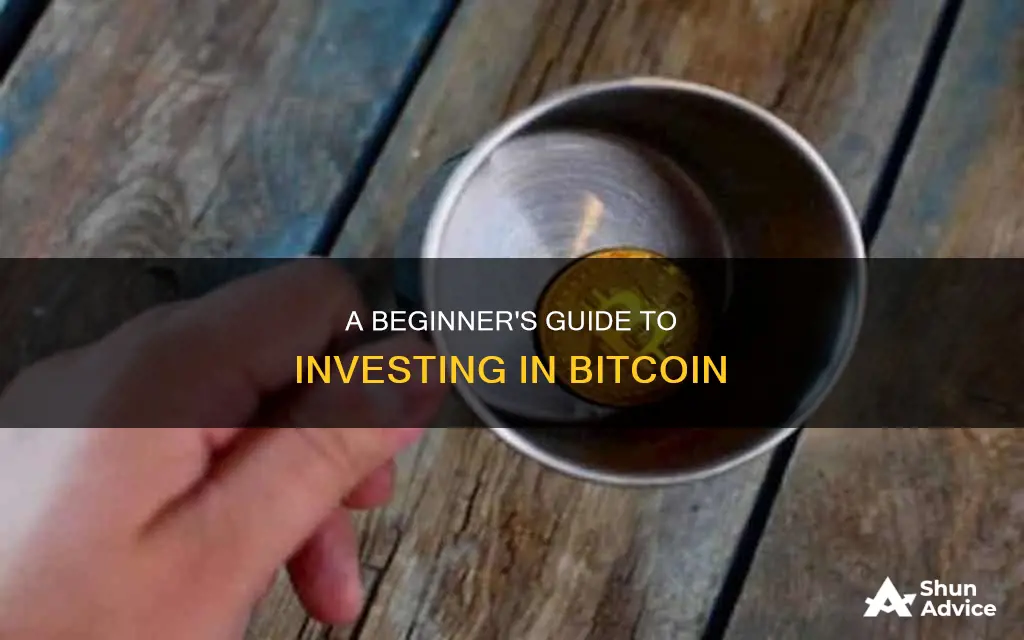
Bitcoin is a popular type of cryptocurrency that utilizes a large chain of interconnected computers to store and protect your digital assets. While it is a very volatile asset that's prone to large and fast swings in value, it also presents an opportunity for large returns.
If you're looking to invest in Bitcoin, you'll need to have all your finances in order. That means having an emergency fund in place, a manageable level of debt, and ideally a diversified portfolio of investments.
- Understand what you're investing in: Research the cryptocurrency market and the specific coin you're interested in.
- Remember, the past is past: Don't get caught up in the past performance of Bitcoin. Focus on the future and what will drive returns.
- Watch that volatility: Be aware of the volatile nature of cryptocurrencies and the potential impact on your investment.
- Don't invest more than you can afford to lose: Only invest money that you are comfortable losing.
- Join a Bitcoin exchange: Sign up with a cryptocurrency exchange such as Coinbase, Binance, or Kraken.
- Get a Bitcoin wallet: Choose between a hot wallet, which is operated by an exchange or provider, or a cold wallet, which is a physical hardware device.
- Connect your wallet to a bank account: Link your wallet or exchange account to your bank account to enable purchases and sales.
- Place your Bitcoin order: Decide how much Bitcoin to purchase, keeping in mind that exchanges often allow you to buy fractions of a single coin.
- Manage your Bitcoin investments: You can use your coins for online transactions, hold them for long-term appreciation, or perform day trading.
It's important to note that investing in Bitcoin carries significant risks, and you should carefully consider your risk tolerance and investment strategy before making any decisions.
| Characteristics | Values |
|---|---|
| Minimum Investment | $25 |
| Types of Wallets | Hot Wallet, Cold Wallet |
| Hot Wallet Providers | Electrum, Mycelium |
| Cold Wallet Devices | Ledger Nano S, Trezor One, Ledger Nano X |
| Cryptocurrency Exchanges | Coinbase, Binance, Kraken, Gemini, Bitfinex |
| Traditional Brokers | Robinhood, Webull, TradeStation, Fidelity, Interactive Brokers |
| Money Transfer Apps | PayPal, Venmo, Cash App |
| Bitcoin ATMs | Walmart |
What You'll Learn

How much money do I need to start investing in Bitcoin?
The amount of money you need to start investing in Bitcoin depends on several factors, including your budget, risk tolerance, and investment strategy. Here are some essential things to consider:
- Personal identification documents: You will need to provide personal information such as your Social Security number and a picture ID.
- Bank account information: You will need to link your bank account or debit/credit card to fund your Bitcoin purchases.
- A secure internet connection: It is crucial to use a private and secure internet connection when making financial transactions involving Bitcoin.
- Minimum investment requirements: Different cryptocurrency exchanges and platforms have varying minimum investment requirements. For example, Coinbase requires a minimum investment of $1 or €1.
- Transaction costs: Different crypto exchanges charge various transaction fees, so it is important to consider these costs when deciding how much to invest.
- Risk tolerance: Bitcoin is a highly volatile and risky investment. It is generally recommended to invest no more than 1% to 5% of your net worth in cryptocurrencies. At Stash, it is suggested to hold no more than 2% of your overall portfolio in any one cryptocurrency to limit crypto-specific risks.
- Investment strategy: Your investment strategy will influence how much money you need to start investing in Bitcoin. For example, if you plan to buy and hold Bitcoin for the long term, you may need a larger initial investment. On the other hand, if you intend to actively trade Bitcoin, you may need a smaller amount to start.
- Diversification: It is generally recommended to diversify your investments across different cryptocurrencies and other asset classes to reduce risk. This means allocating a smaller portion of your portfolio to Bitcoin and investing in multiple coins.
In summary, the amount of money you need to start investing in Bitcoin depends on various factors, including your financial situation, risk tolerance, and investment strategy. It is crucial to carefully consider these factors and conduct thorough research before investing in Bitcoin or any other cryptocurrency. Remember that Bitcoin is a highly volatile and risky asset, and you should never invest more than you can afford to lose.
Borrowing to Buy Bitcoin: A Risky Investment Strategy?
You may want to see also

How to choose a Bitcoin exchange
When choosing a Bitcoin exchange, there are several factors to consider. Here are some key points to help you make an informed decision:
Geographical Location and Restrictions:
It is essential to ensure that the exchange is accessible from your country and complies with the local laws and regulations. Some exchanges may have restrictions based on economic and trade sanctions or other factors. Check if the exchange has the necessary licensing and certifications to operate in your region.
Volume and Liquidity:
A large trading volume is usually a good indicator of a crypto exchange's liquidity and ability to fill orders promptly. If you plan to trade popular coins like Bitcoin or Ethereum, consider a major centralized exchange for higher liquidity. For smaller coins and ERC20 tokens, explore smaller or decentralized exchanges.
Security, Anonymity, and Support:
With significant losses and hacks occurring, security should be a top priority. While centralized exchanges offer higher liquidity, they are also attractive targets for phishing scams and hacks. Decentralized exchanges emphasize security and anonymity by allowing users to sign up without revealing personal information. Look for exchanges that offer two-factor authentication and anonymous sign-ups.
Reputation and Customer Service:
Research the exchange's reputation by reading customer reviews and assessing its security track record. Check if there have been any past malicious attacks, phishing scams, or issues with withdrawals. Also, consider the quality of customer support, especially if you're new to cryptocurrency investing.
Fees and Payment Methods:
Compare the fees charged by different exchanges, including trading fees, withdrawal fees, and transaction fees. Additionally, ensure that the exchange supports your preferred payment method, such as wire transfers, credit cards, or debit cards.
Regulatory Compliance:
Ensure that the exchange complies with Know Your Customer (KYC) and Anti-Money Laundering (AML) procedures. This demonstrates a commitment to security and helps bring crypto closer to mainstream acceptance.
Remember, choosing the right exchange is crucial for a secure and positive investing experience. Always conduct thorough research and consider your specific needs and preferences before making a decision.
A Beginner's Guide to Investing in Bitcoin with GBTC
You may want to see also

How to set up a Bitcoin wallet
Setting up a Bitcoin wallet is a crucial step in investing in Bitcoin. Here is a step-by-step guide on how to set up a Bitcoin wallet:
Choose the Right Bitcoin Wallet for You:
There are several types of Bitcoin wallets, including hosted wallets, non-custodial wallets, and hardware wallets.
- Hosted wallets are the most popular and easy to set up. When you buy Bitcoin through an app, your crypto is automatically stored in a hosted wallet. It's similar to a bank account, where a third party securely holds your money.
- Non-custodial wallets, also known as self-custody wallets, give you complete control over your crypto. You are responsible for safeguarding your password or private key.
- Hardware wallets are physical devices, like a thumb drive, that store your private keys offline. They offer increased security but are more complex and costly.
Select a Platform:
If you choose a hosted wallet, select a platform you trust, considering factors like security, ease of use, and compliance with regulations. Popular platforms include Coinbase, Gemini, Kraken, Crypto.com, and Robinhood.
Create Your Account:
For a hosted wallet, enter your personal information and create a secure password. Consider using two-factor authentication (2FA) for added security.
For a non-custodial wallet, you typically don't need to provide personal information, not even an email address. However, it's crucial to write down and securely store your private key, which is usually a random 12-word phrase.
Buy or Transfer Bitcoin:
With a hosted wallet, you can buy crypto using a bank account or credit card. You can also transfer crypto to your wallet if you already own some.
With a non-custodial wallet, you usually can't buy crypto with traditional currencies, so you'll need to transfer crypto from another source.
Install Software (For Hardware Wallets):
If you opt for a hardware wallet, you'll need to purchase the hardware from brands like Ledger or Trezor and then install the necessary software from the official company website.
Understand Hot Wallets vs. Cold Wallets:
Online or hot wallets are connected to the internet and are typically apps on your computer or mobile device. They are convenient for small amounts of crypto or active trading. However, they are more susceptible to security breaches.
Cold wallets, on the other hand, are offline storage methods, such as hardware wallets or paper wallets. They are considered much more secure but require technical knowledge to set up.
Remember to always enable two-factor authentication and use strong passwords to protect your Bitcoin wallet and its contents.
Harvard's Bitcoin Endowment: Exploring Crypto Investments
You may want to see also

How to connect your wallet to a bank account
The amount of money required to start investing in Bitcoin is flexible. Some crypto exchanges have minimum purchases of $10 or less, and Coinbase requires a minimum investment of $1 or €1 of your local currency.
Now, to connect your wallet to a bank account:
Step 1: Choose a Crypto-Trading Service or Venue
You can use a cryptocurrency exchange, brokerage firm, or payment service like PayPal. Exchanges are a convenient option because they offer a breadth of features and more cryptocurrencies for trading. Popular exchanges in the U.S. include Coinbase, Kraken, Gemini, and Binance. When creating an account, use two-factor authentication and a strong password.
Step 2: Connect Your Exchange to a Payment Option
You can connect your bank account directly to most exchanges, or link a debit or credit card. You will likely need to provide personal identification, such as a picture of your driver's license or Social Security card.
Step 3: Place an Order
Crypto exchanges offer several order types and ways to invest. Almost all crypto exchanges offer market and limit orders, and some also provide stop-loss orders.
Step 4: Safe Storage
You can keep your crypto in an exchange wallet, but this is not recommended for large or long-term cryptocurrency holdings. Instead, you can use a hot wallet or a cold wallet. Hot wallets are apps on internet-connected devices, such as computers or phones, and are best for small amounts of cryptocurrency. Cold wallets are not connected to the internet and are considered more secure. These include paper wallets and hardware wallets.
Step 5: Transfer Crypto to Your Bank Account
You can transfer crypto to your bank account using a SWIFT/SEPA transfer or a P2P exchange. For the former, you will need to enter your bank account details, including the IBAN number for SEPA transfers or the SWIFT/BIC code for SWIFT transfers. For a P2P exchange, you will need to find a buyer and wait for them to transfer the money to your bank account.
Bitcoin: Currency or Investment?
You may want to see also

How to manage your Bitcoin investments
Step 1: Choose a Reputable Exchange
When selecting a cryptocurrency exchange, consider factors such as security, fees, trading volume, minimum investment requirements, and the types of cryptocurrencies available. Popular exchanges include Coinbase, Gemini, Kraken, and Binance.
Step 2: Set Up a Digital Wallet
You can choose between a "hot wallet" and a "cold wallet." A hot wallet is accessible via the internet and is typically provided by your exchange. It is more convenient but less secure. A cold wallet, on the other hand, is a physical device, like a USB drive, that stores your cryptocurrency keys offline, providing an extra layer of security.
Step 3: Connect Your Wallet to a Bank Account
Linking your wallet to your bank account enables you to purchase and sell coins. Alternatively, you can link your bank account directly to your exchange account.
Step 4: Place Your Bitcoin Order
When placing your order, consider your risk tolerance and investment strategy. Bitcoin is a highly volatile asset, so proceed with caution. You can purchase fractions of a Bitcoin, with some exchanges allowing investments as low as $25.
Step 5: Manage Your Bitcoin Investments
You can use your Bitcoin for online transactions, hold it long-term, or perform day trading. Your chosen exchange will provide the tools needed for buying and selling. Remember to review your investment strategy regularly and make adjustments as necessary.
Billions Invested in Bitcoin: How Much and By Whom?
You may want to see also
Frequently asked questions
In theory, it takes only a few dollars to invest in Bitcoin. Most crypto exchanges have a minimum trade of $5 or $10. However, it’s important to note that some trading platforms will take a large chunk of your investment as a fee if you’re trading small amounts of cryptocurrency.
You can buy Bitcoin through a cryptocurrency exchange like Coinbase, Gemini, or Kraken. You can also use a traditional broker like Robinhood or Interactive Brokers. Other options include financial apps such as PayPal, Venmo, and Cash App, or a Bitcoin ATM.
A potential pro of investing in Bitcoin is that you may be able to generate a huge return on profit, perhaps as high as 200% or more. On the other hand, a con of investing in Bitcoin is that it is a very high-risk investment. Its value may rise or fall dramatically in a very short period, and it is prone to “pump-and-dump” schemes.
You can store your Bitcoin in a hot wallet or a cold wallet. A hot wallet is a wallet that’s operated by either your cryptocurrency exchange or by a provider. A cold wallet is a physical piece of hardware, usually a portable device similar to a flash drive, that stores your coins offline.
There is no one-size-fits-all answer to this question. It depends entirely on your risk tolerance, investment strategy, and financial goals. Bitcoin is a very high-risk and volatile investment, so carefully consider these factors before investing.







